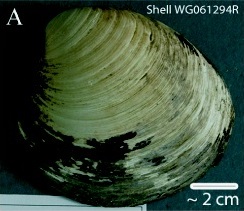Ming (clam)
== Ming (Clam) ==
Ming is a type of clam that belongs to the family Mingidae. These clams are known for their longevity and are found in various marine environments around the world. The Ming clam is characterized by its hard shell and muscular foot, which it uses to burrow into the sand or mud at the bottom of the ocean.
Description[edit | edit source]
Ming clams are typically small in size, with a shell that can range in color from white to brown. They have a soft body enclosed within the shell, which consists of a foot, gills, and a siphon used for filter feeding. The lifespan of a Ming clam can exceed several hundred years, making them one of the longest-lived organisms on Earth.
Habitat and Distribution[edit | edit source]
Ming clams are commonly found in shallow coastal waters, where they burrow into the substrate to protect themselves from predators. They are distributed across various regions, including the Atlantic Ocean, Pacific Ocean, and Indian Ocean. Ming clams prefer sandy or muddy bottoms where they can easily burrow and feed on organic matter.
Reproduction[edit | edit source]
Ming clams reproduce by releasing eggs and sperm into the water, where fertilization takes place externally. The larvae that hatch from the eggs drift in the water column before settling on the ocean floor and developing into adult clams. Reproduction in Ming clams is influenced by factors such as water temperature, salinity, and food availability.
Conservation Status[edit | edit source]
Due to their long lifespan and slow growth rate, Ming clams are vulnerable to environmental changes and human activities. Overfishing and habitat destruction have led to a decline in Ming clam populations in some regions. Conservation efforts are underway to protect these unique organisms and their habitats.
References[edit | edit source]
Search WikiMD
Ad.Tired of being Overweight? Try W8MD's physician weight loss program.
Semaglutide (Ozempic / Wegovy and Tirzepatide (Mounjaro / Zepbound) available.
Advertise on WikiMD
|
WikiMD's Wellness Encyclopedia |
| Let Food Be Thy Medicine Medicine Thy Food - Hippocrates |
Translate this page: - East Asian
中文,
日本,
한국어,
South Asian
हिन्दी,
தமிழ்,
తెలుగు,
Urdu,
ಕನ್ನಡ,
Southeast Asian
Indonesian,
Vietnamese,
Thai,
မြန်မာဘာသာ,
বাংলা
European
español,
Deutsch,
français,
Greek,
português do Brasil,
polski,
română,
русский,
Nederlands,
norsk,
svenska,
suomi,
Italian
Middle Eastern & African
عربى,
Turkish,
Persian,
Hebrew,
Afrikaans,
isiZulu,
Kiswahili,
Other
Bulgarian,
Hungarian,
Czech,
Swedish,
മലയാളം,
मराठी,
ਪੰਜਾਬੀ,
ગુજરાતી,
Portuguese,
Ukrainian
Medical Disclaimer: WikiMD is not a substitute for professional medical advice. The information on WikiMD is provided as an information resource only, may be incorrect, outdated or misleading, and is not to be used or relied on for any diagnostic or treatment purposes. Please consult your health care provider before making any healthcare decisions or for guidance about a specific medical condition. WikiMD expressly disclaims responsibility, and shall have no liability, for any damages, loss, injury, or liability whatsoever suffered as a result of your reliance on the information contained in this site. By visiting this site you agree to the foregoing terms and conditions, which may from time to time be changed or supplemented by WikiMD. If you do not agree to the foregoing terms and conditions, you should not enter or use this site. See full disclaimer.
Credits:Most images are courtesy of Wikimedia commons, and templates, categories Wikipedia, licensed under CC BY SA or similar.
Contributors: Prab R. Tumpati, MD


